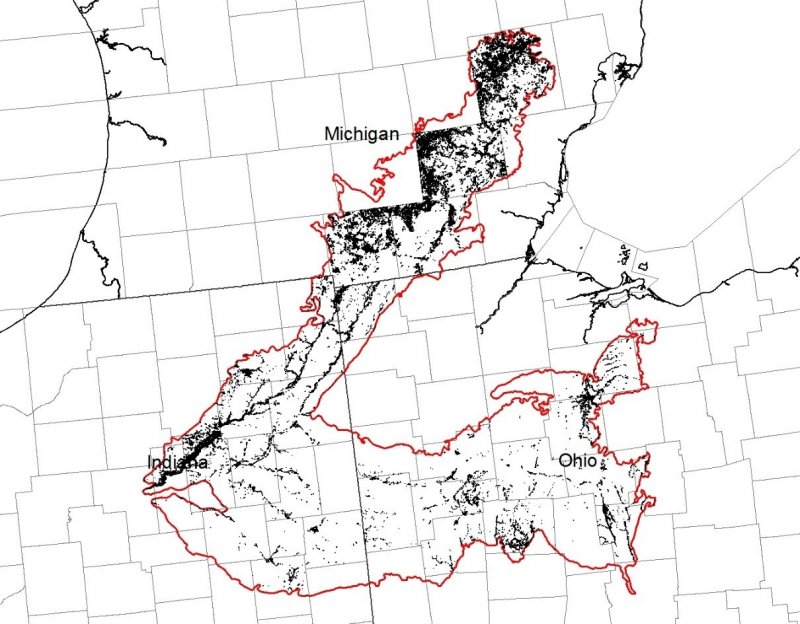
Natural Resources
Conservation Service
Ecological site F111XB404IN
Dry Outwash Upland
Last updated: 9/11/2024
Accessed: 04/29/2025
General information
Provisional. A provisional ecological site description has undergone quality control and quality assurance review. It contains a working state and transition model and enough information to identify the ecological site.
MLRA notes
Major Land Resource Area (MLRA): 111X–Indiana and Ohio Till Plain
This PROVISIONAL ECOLOGICAL SITE has been developed to meet the standards established in the National Ecological Site Handbook. The information associated with this ecological site does not meet the Approved Ecological Site Description Standard, but it has been through a Quality Control and Quality Assurance processes to assure consistency and completeness. Further investigations, reviews and correlations are necessary before it becomes an Approved Ecological Site Description.
111B – Indiana and Ohio Till Plain, Northeastern Part. This area is in the Eastern Lake and Till Plains Sections of the Central Lowland Province of the Interior Plains. The entire MLRA is glaciated, and most areas are dominated by ground moraines that are broken in places by lake plains, outwash plains, flood plains, and many recessional moraines. The ground moraines and lake plains in front of the recessional moraines are flat to undulating. In many places stream valleys occur at the leading edge of the recessional moraines. Narrow, shallow valleys commonly are along the major rivers and streams in this MLRA, and some areas along the major rivers and streams have deposits of sand. Elevation ranges from 630 to 1,550 feet (190 to 470 meters), increasing gradually from west to east. Relief is mainly a few meters, but in some areas hills rise as much as 100 feet (30 meters) above the adjoining plains.
The extent of the major Hydrologic Unit Areas (identified by four-digit numbers) that make up this MLRA is as follows: Western Lake Erie (0410), 41 percent; Wabash (0512), 28 percent; Scioto (0, 28 percent; Scioto (0506), 10 percent; St. Clair-Detroit (0409), 9 percent; Great Miami (0508), 6 percent; Southeastern Lake Michigan (0405), 5 percent; and Southwestern Lake Huron (0408), 1 percent. The Huron River in Michigan, Cedar Creek in Indiana, and the Sandusky River in Ohio have been designated as National Wild and Scenic Rivers in this MLRA.
The surficial materials in this area include glacial deposits of till, outwash, and lacustrine sediments from Wisconsin and older glacial periods. A thin mantle of loess occurs in some areas. Most of the MLRA is underlain by Silurian and Devonian limestone and dolostone. Middle Devonian to Early Mississippian black shale and Early to Middle Mississippian siltstone and shale are in some areas of the northern part of the MLRA.
Classification relationships
Major Land Resource Area (USDA-Natural Resources Conservation Service, 2006)
USFS Ecological Regions (USDA, 2007):
Sections –Central Till Plains, Beech Maple (222H), South Central Great Lakes (222J)
Subsections – Bluffton Till Plains (222Ha), Bluffton-Ann Arbor Till Plains (222Je), Jackson Interlobate Moraine (222Jg), Steuben Interlobate Moraines (222Ji)
NatureServe Systems anticipated (NatureServe, 2011): Agriculture - Cultivated Crops and Irrigated Agriculture, Agriculture – Pasture/Hay, North-Central Interior Dry-Mesic Oak Forest and Woodland, North-Central Interior Beech-Maple Forest, Ruderal Forest
LANDFIRE Biophysical Settings anticipated (USGS, 2010): North-Central Interior Dry-Mesic Oak Forest and Woodland, North-Central Interior Beech-Maple Forest
Ecological site concept
Ecological Site Concept
This site is an upland site formed on glacial outwash parent materials in soils that are moderately well drained or drier. The soils have a relatively light soil surface color (lighter than 3/2 Munsell) with a surface modifier of cobbly, gravelly, or very gravelly. This site is found on, generally, steeper topography than the Outwash Upland, though the range of slopes (0 to 25 percent) is the same. The topography and courser materials leads this site to being better drained and drier.
The characteristic vegetation of the site is that of a somewhat dry forest dominated largely by oak species, such as white oak and black oak that can tolerate the increased drainage of the site. Hickory species are also common throughout the site along with sugar maple in somewhat fire protected areas, black cherry, and sassafras. Moderate fire return interval (40-60yrs) for low intensity fires and stand replacing fires every 100-200yrs contributed to the dominance of oak species on the site. Changes in the fire regime have led to many of the extant representation of the site to have a greater amount of fire sensitive, shade tolerate species occupying both the understory and canopy than what was present at the time of European settlement. In this state, the site progress through a phase that in characterized by a co-dominance in the canopy of oaks and sugar maples. Continued absence of fire or lack of timber stand management allows the site to more resemble a mesic forest as dominated by sugar maple and American beech. Currently, the majority of the site is in agricultural production, with the majority being used for growing corn and soybeans, though some areas are used for growing cool season forage and pasture.
Associated sites
| R111XB401IN |
Wet Outwash Mollisol Soils are in the aquic taxonomic suborder and are very poorly to poorly drained. |
|---|---|
| R111XB402IN |
Dry Outwash Integrade Soils not in aquic taxonomic suborder and are SWPD or drier |
| F111XB403IN |
Outwash Upland Soil surface is light in color (lighter than 3/2 Munsell) |
Similar sites
| F111XB303IN |
Dry Bedrock Forest Dry Bedrock Forest |
|---|---|
| R111XB402IN |
Dry Outwash Integrade Dry Outwash Integrade |
Table 1. Dominant plant species
| Tree |
(1) Quercus alba |
|---|---|
| Shrub |
Not specified |
| Herbaceous |
Not specified |
Click on box and path labels to scroll to the respective text.



